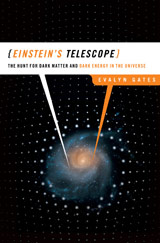
|
|||
|
|||
| Home |
| Gallery |
| Culture/ Technology |
| Fiction |
| Music |
| Poetry |
| Theater |
| What's New |
| About/Contact |
| Archive |
|
A solid introduction to gravity lensing, dark matter Reviewed May 2009
Further evidence of Einstein's genius in changing how we view the universe is the ongoing development of our understanding of gravity lensing – a natural phenomenon predicted by Einstein's theories of relativity and later confirmed. If we've long known that gravity bends the path of a photon (or beam of light), we didn't necessarily grasp the full implications of that until recently. Evalyn Gates' new book on the topic explains the hows and whys of gravity lensing in easy to understand language – and then illustrates how this phenomenon is being used to try to answer one of the most vexing questions facing cosmologists today: Where is all the matter? It turns out that in measuring the rotation speed of galaxies, they're all spinning much faster than they should be given our understanding of the mass of stars and the number of stars in these galaxies. They should be flying apart at those speeds, but they're not. So what's holding them together? The consensus right now is a yet-to-be-confirmed new substance astronomers call "dark matter" – composed of particles unknown to us, and not found in our corner of the universe. Or at least not yet seen or otherwise identified by our best researchers. But Gates writes that the more astronmers study the optical effects of massive gravity wells, like giant galactic clusters, on passing light rays the more they're convinced that dark matter must exist. See, in addition to the too-fast rotation of galaxies about their centers, there's the fact that objects behind galaxies (from our perspective) are having their images distorted by said galaxies' gravity wells far more than they should. Something other than the mass that we can add up from the stars, interstellar dust and black holes is exerting a powerful gravitational pull on both the stars and the light they emit. (There's also the interesting fact that many of the strange objects we thought we were seeing in the night sky – like arc-shaped galaxies – are really only distortions of normal astronomical structures, warped by a gravity lens between them and us. And that there are many duplicate objects in the night sky, multiple images of the same object created by oddly shaped gravity lenses, like galactic clusters.) Gates' book is a solid, easy to understand introduction to both gravity lensing and the search for dark matter. She writes in clear, concise prose that never talks down to the reader. Rather, like the late Carl Sagan, she treats her readers as intelligent, educated people who happen not to be experts in a very specialized field of study – like colleagues from a different line of research. |

